Primary Health Care in Action: Determinants and Strategies Report
VerifiedAdded on 2022/09/12
|7
|1933
|20
Report
AI Summary
This report examines primary health care initiatives within the Gnibi and Kalumburu communities, focusing on social determinants of health such as access to education, economic opportunities, and exposure to trauma and violence. The report analyzes the effectiveness of community health programs, emphasizing the importance of client autonomy, beneficence, and cultural competence. It highlights how the Ottawa Charter's principles of health promotion, equity, and empowerment are implemented to improve healthcare access and outcomes. The report also explores the role of cultural competence in fostering effective communication and addressing health disparities. The Gnibi College program's approach to supporting community members in developing their own solutions and rebuilding social structures is discussed, with an emphasis on the importance of addressing historical trauma and socioeconomic factors. The report concludes by underscoring the significance of community involvement, health literacy, and culturally sensitive healthcare practices in promoting sustainable health solutions.
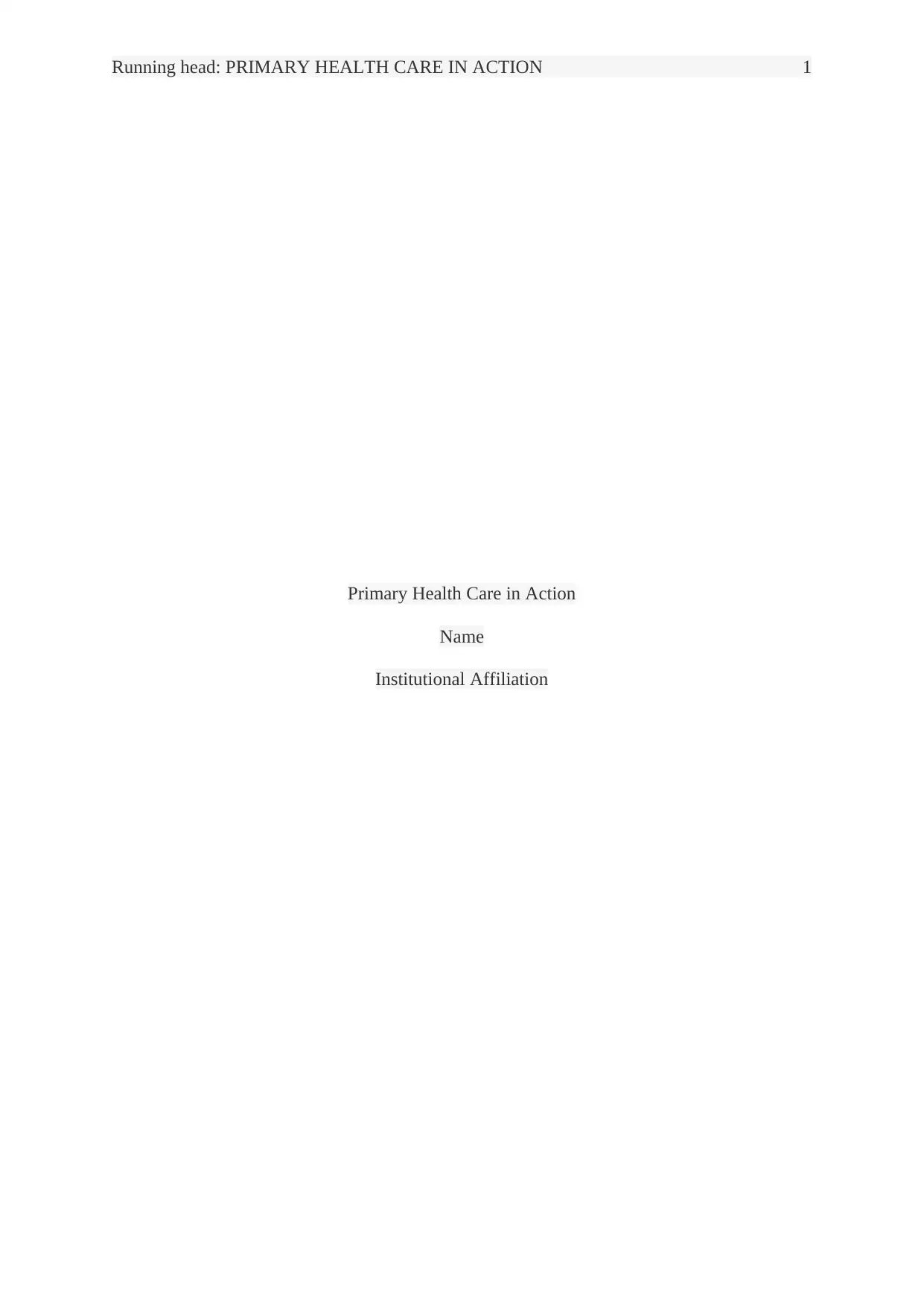
Running head: PRIMARY HEALTH CARE IN ACTION 1
Primary Health Care in Action
Name
Institutional Affiliation
Primary Health Care in Action
Name
Institutional Affiliation
Paraphrase This Document
Need a fresh take? Get an instant paraphrase of this document with our AI Paraphraser
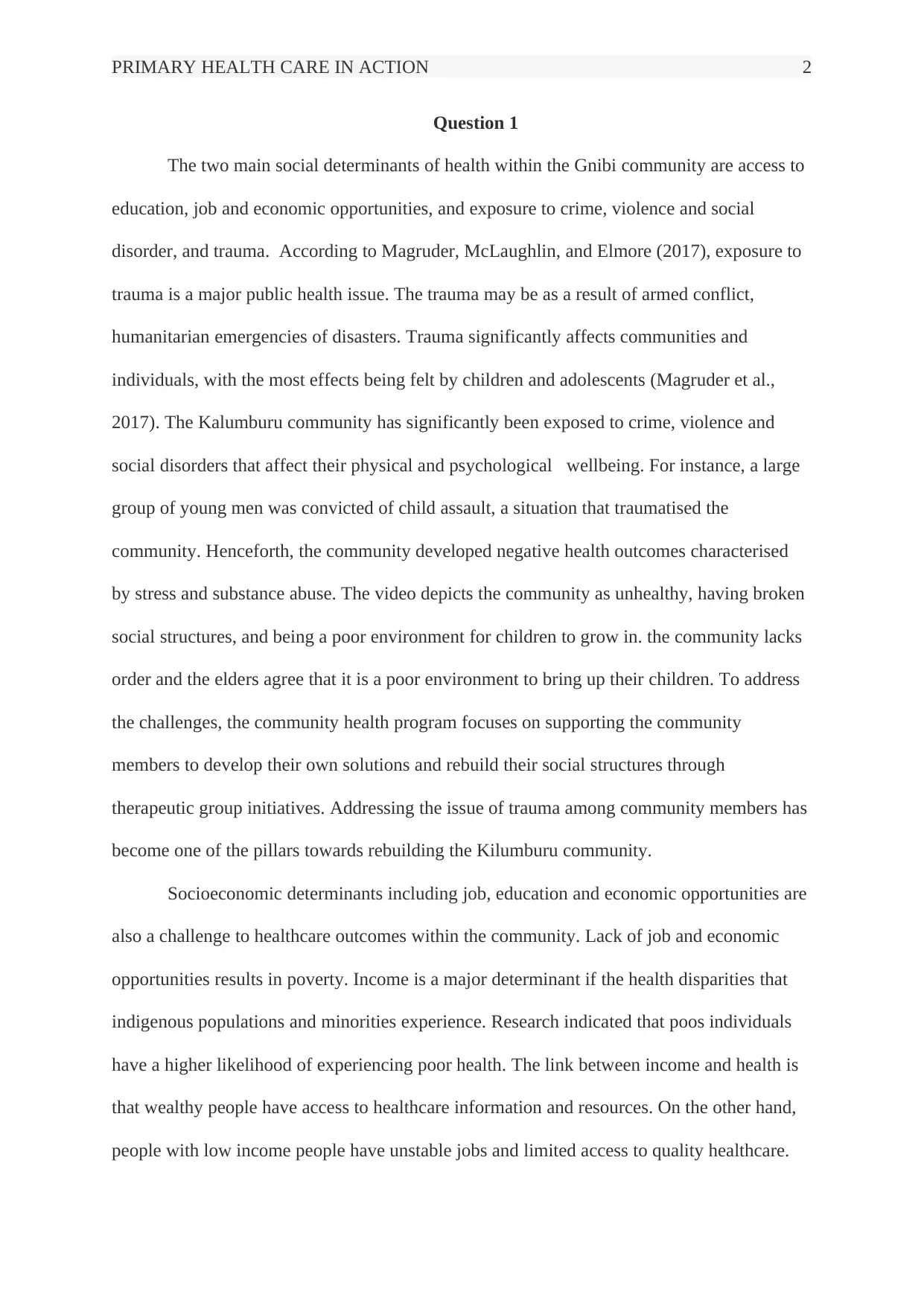
PRIMARY HEALTH CARE IN ACTION 2
Question 1
The two main social determinants of health within the Gnibi community are access to
education, job and economic opportunities, and exposure to crime, violence and social
disorder, and trauma. According to Magruder, McLaughlin, and Elmore (2017), exposure to
trauma is a major public health issue. The trauma may be as a result of armed conflict,
humanitarian emergencies of disasters. Trauma significantly affects communities and
individuals, with the most effects being felt by children and adolescents (Magruder et al.,
2017). The Kalumburu community has significantly been exposed to crime, violence and
social disorders that affect their physical and psychological wellbeing. For instance, a large
group of young men was convicted of child assault, a situation that traumatised the
community. Henceforth, the community developed negative health outcomes characterised
by stress and substance abuse. The video depicts the community as unhealthy, having broken
social structures, and being a poor environment for children to grow in. the community lacks
order and the elders agree that it is a poor environment to bring up their children. To address
the challenges, the community health program focuses on supporting the community
members to develop their own solutions and rebuild their social structures through
therapeutic group initiatives. Addressing the issue of trauma among community members has
become one of the pillars towards rebuilding the Kilumburu community.
Socioeconomic determinants including job, education and economic opportunities are
also a challenge to healthcare outcomes within the community. Lack of job and economic
opportunities results in poverty. Income is a major determinant if the health disparities that
indigenous populations and minorities experience. Research indicated that poos individuals
have a higher likelihood of experiencing poor health. The link between income and health is
that wealthy people have access to healthcare information and resources. On the other hand,
people with low income people have unstable jobs and limited access to quality healthcare.
Question 1
The two main social determinants of health within the Gnibi community are access to
education, job and economic opportunities, and exposure to crime, violence and social
disorder, and trauma. According to Magruder, McLaughlin, and Elmore (2017), exposure to
trauma is a major public health issue. The trauma may be as a result of armed conflict,
humanitarian emergencies of disasters. Trauma significantly affects communities and
individuals, with the most effects being felt by children and adolescents (Magruder et al.,
2017). The Kalumburu community has significantly been exposed to crime, violence and
social disorders that affect their physical and psychological wellbeing. For instance, a large
group of young men was convicted of child assault, a situation that traumatised the
community. Henceforth, the community developed negative health outcomes characterised
by stress and substance abuse. The video depicts the community as unhealthy, having broken
social structures, and being a poor environment for children to grow in. the community lacks
order and the elders agree that it is a poor environment to bring up their children. To address
the challenges, the community health program focuses on supporting the community
members to develop their own solutions and rebuild their social structures through
therapeutic group initiatives. Addressing the issue of trauma among community members has
become one of the pillars towards rebuilding the Kilumburu community.
Socioeconomic determinants including job, education and economic opportunities are
also a challenge to healthcare outcomes within the community. Lack of job and economic
opportunities results in poverty. Income is a major determinant if the health disparities that
indigenous populations and minorities experience. Research indicated that poos individuals
have a higher likelihood of experiencing poor health. The link between income and health is
that wealthy people have access to healthcare information and resources. On the other hand,
people with low income people have unstable jobs and limited access to quality healthcare.
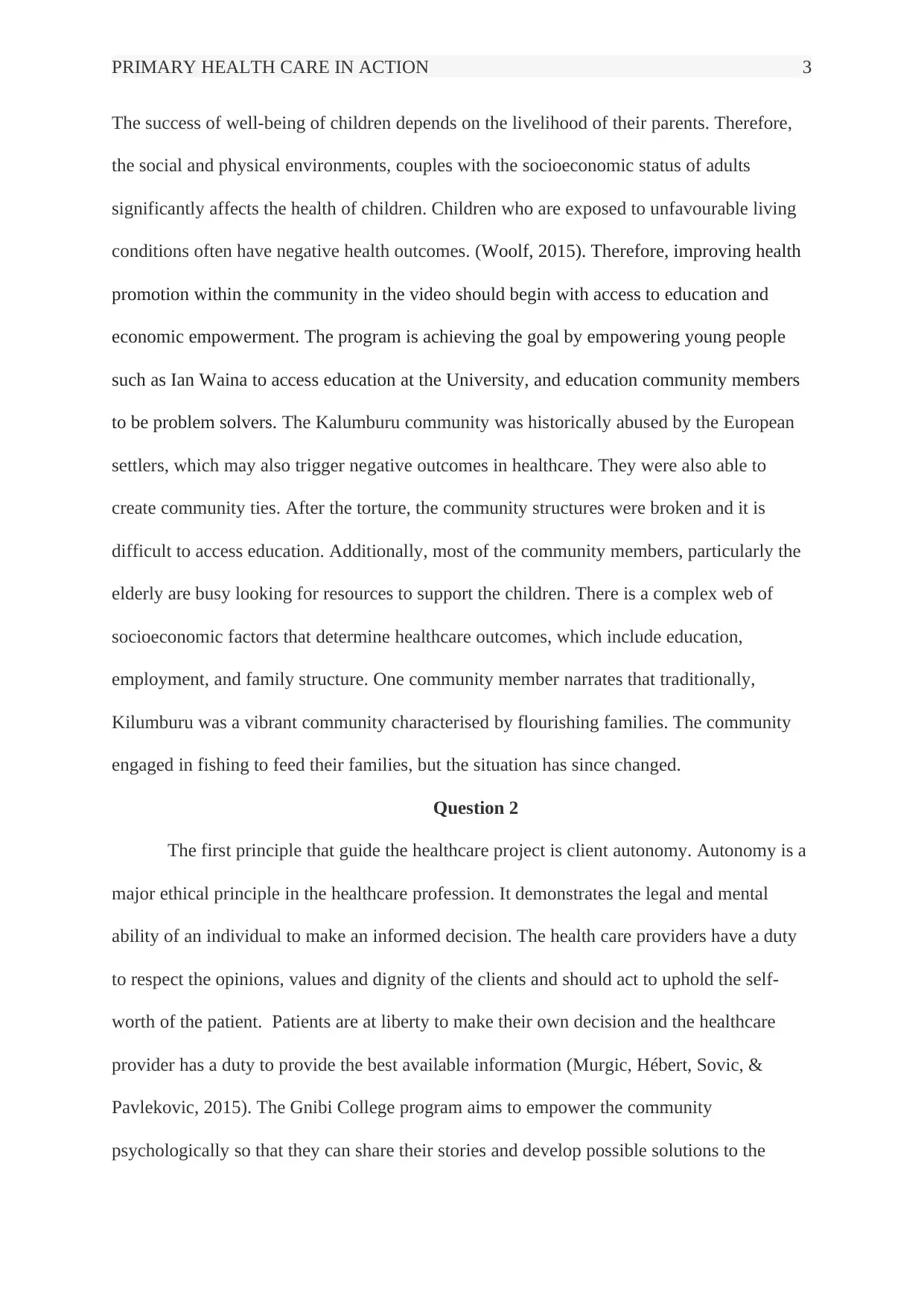
PRIMARY HEALTH CARE IN ACTION 3
The success of well-being of children depends on the livelihood of their parents. Therefore,
the social and physical environments, couples with the socioeconomic status of adults
significantly affects the health of children. Children who are exposed to unfavourable living
conditions often have negative health outcomes. (Woolf, 2015). Therefore, improving health
promotion within the community in the video should begin with access to education and
economic empowerment. The program is achieving the goal by empowering young people
such as Ian Waina to access education at the University, and education community members
to be problem solvers. The Kalumburu community was historically abused by the European
settlers, which may also trigger negative outcomes in healthcare. They were also able to
create community ties. After the torture, the community structures were broken and it is
difficult to access education. Additionally, most of the community members, particularly the
elderly are busy looking for resources to support the children. There is a complex web of
socioeconomic factors that determine healthcare outcomes, which include education,
employment, and family structure. One community member narrates that traditionally,
Kilumburu was a vibrant community characterised by flourishing families. The community
engaged in fishing to feed their families, but the situation has since changed.
Question 2
The first principle that guide the healthcare project is client autonomy. Autonomy is a
major ethical principle in the healthcare profession. It demonstrates the legal and mental
ability of an individual to make an informed decision. The health care providers have a duty
to respect the opinions, values and dignity of the clients and should act to uphold the self-
worth of the patient. Patients are at liberty to make their own decision and the healthcare
provider has a duty to provide the best available information (Murgic, Hébert, Sovic, &
Pavlekovic, 2015). The Gnibi College program aims to empower the community
psychologically so that they can share their stories and develop possible solutions to the
The success of well-being of children depends on the livelihood of their parents. Therefore,
the social and physical environments, couples with the socioeconomic status of adults
significantly affects the health of children. Children who are exposed to unfavourable living
conditions often have negative health outcomes. (Woolf, 2015). Therefore, improving health
promotion within the community in the video should begin with access to education and
economic empowerment. The program is achieving the goal by empowering young people
such as Ian Waina to access education at the University, and education community members
to be problem solvers. The Kalumburu community was historically abused by the European
settlers, which may also trigger negative outcomes in healthcare. They were also able to
create community ties. After the torture, the community structures were broken and it is
difficult to access education. Additionally, most of the community members, particularly the
elderly are busy looking for resources to support the children. There is a complex web of
socioeconomic factors that determine healthcare outcomes, which include education,
employment, and family structure. One community member narrates that traditionally,
Kilumburu was a vibrant community characterised by flourishing families. The community
engaged in fishing to feed their families, but the situation has since changed.
Question 2
The first principle that guide the healthcare project is client autonomy. Autonomy is a
major ethical principle in the healthcare profession. It demonstrates the legal and mental
ability of an individual to make an informed decision. The health care providers have a duty
to respect the opinions, values and dignity of the clients and should act to uphold the self-
worth of the patient. Patients are at liberty to make their own decision and the healthcare
provider has a duty to provide the best available information (Murgic, Hébert, Sovic, &
Pavlekovic, 2015). The Gnibi College program aims to empower the community
psychologically so that they can share their stories and develop possible solutions to the
⊘ This is a preview!⊘
Do you want full access?
Subscribe today to unlock all pages.

Trusted by 1+ million students worldwide
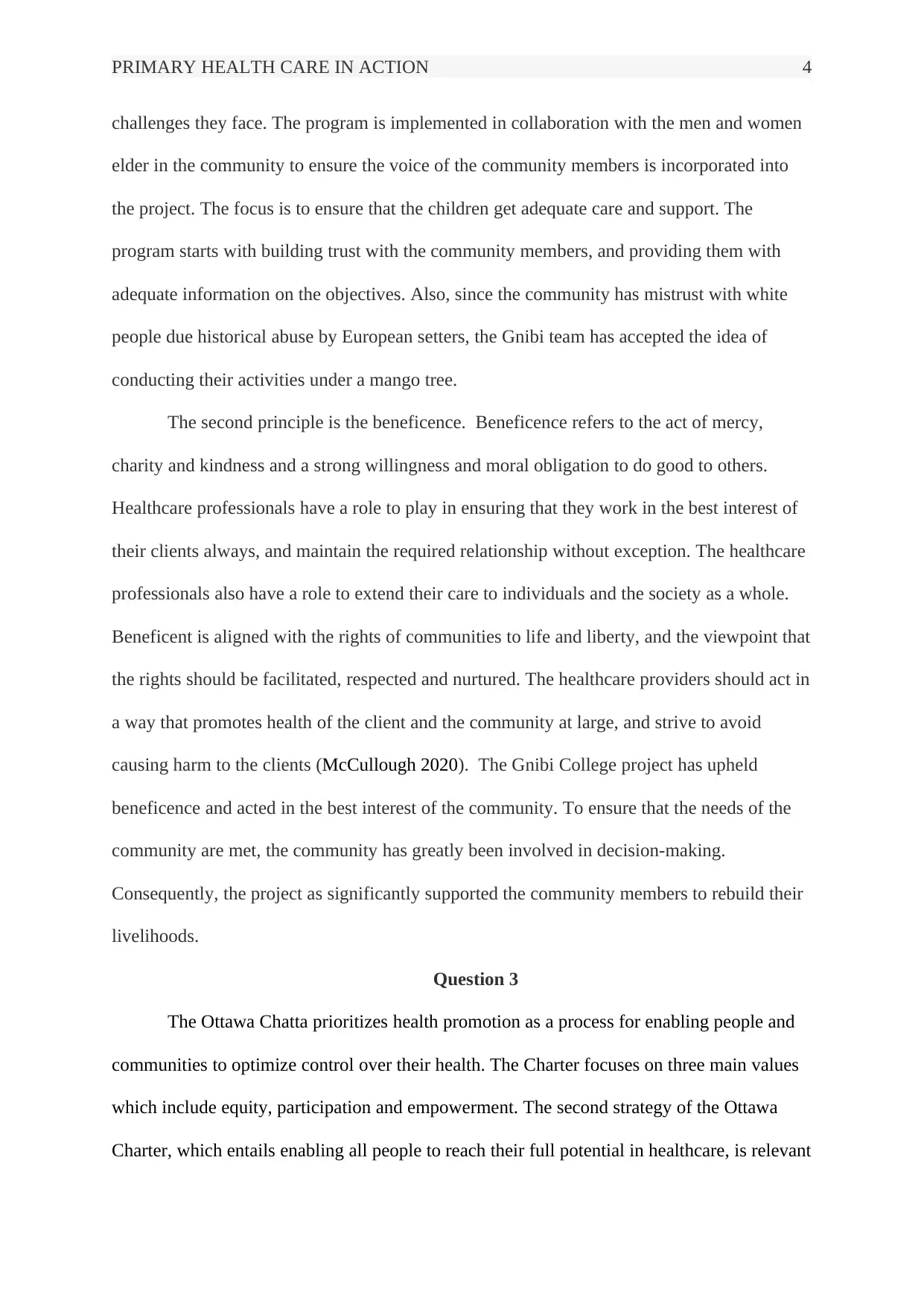
PRIMARY HEALTH CARE IN ACTION 4
challenges they face. The program is implemented in collaboration with the men and women
elder in the community to ensure the voice of the community members is incorporated into
the project. The focus is to ensure that the children get adequate care and support. The
program starts with building trust with the community members, and providing them with
adequate information on the objectives. Also, since the community has mistrust with white
people due historical abuse by European setters, the Gnibi team has accepted the idea of
conducting their activities under a mango tree.
The second principle is the beneficence. Beneficence refers to the act of mercy,
charity and kindness and a strong willingness and moral obligation to do good to others.
Healthcare professionals have a role to play in ensuring that they work in the best interest of
their clients always, and maintain the required relationship without exception. The healthcare
professionals also have a role to extend their care to individuals and the society as a whole.
Beneficent is aligned with the rights of communities to life and liberty, and the viewpoint that
the rights should be facilitated, respected and nurtured. The healthcare providers should act in
a way that promotes health of the client and the community at large, and strive to avoid
causing harm to the clients (McCullough 2020). The Gnibi College project has upheld
beneficence and acted in the best interest of the community. To ensure that the needs of the
community are met, the community has greatly been involved in decision-making.
Consequently, the project as significantly supported the community members to rebuild their
livelihoods.
Question 3
The Ottawa Chatta prioritizes health promotion as a process for enabling people and
communities to optimize control over their health. The Charter focuses on three main values
which include equity, participation and empowerment. The second strategy of the Ottawa
Charter, which entails enabling all people to reach their full potential in healthcare, is relevant
challenges they face. The program is implemented in collaboration with the men and women
elder in the community to ensure the voice of the community members is incorporated into
the project. The focus is to ensure that the children get adequate care and support. The
program starts with building trust with the community members, and providing them with
adequate information on the objectives. Also, since the community has mistrust with white
people due historical abuse by European setters, the Gnibi team has accepted the idea of
conducting their activities under a mango tree.
The second principle is the beneficence. Beneficence refers to the act of mercy,
charity and kindness and a strong willingness and moral obligation to do good to others.
Healthcare professionals have a role to play in ensuring that they work in the best interest of
their clients always, and maintain the required relationship without exception. The healthcare
professionals also have a role to extend their care to individuals and the society as a whole.
Beneficent is aligned with the rights of communities to life and liberty, and the viewpoint that
the rights should be facilitated, respected and nurtured. The healthcare providers should act in
a way that promotes health of the client and the community at large, and strive to avoid
causing harm to the clients (McCullough 2020). The Gnibi College project has upheld
beneficence and acted in the best interest of the community. To ensure that the needs of the
community are met, the community has greatly been involved in decision-making.
Consequently, the project as significantly supported the community members to rebuild their
livelihoods.
Question 3
The Ottawa Chatta prioritizes health promotion as a process for enabling people and
communities to optimize control over their health. The Charter focuses on three main values
which include equity, participation and empowerment. The second strategy of the Ottawa
Charter, which entails enabling all people to reach their full potential in healthcare, is relevant
Paraphrase This Document
Need a fresh take? Get an instant paraphrase of this document with our AI Paraphraser
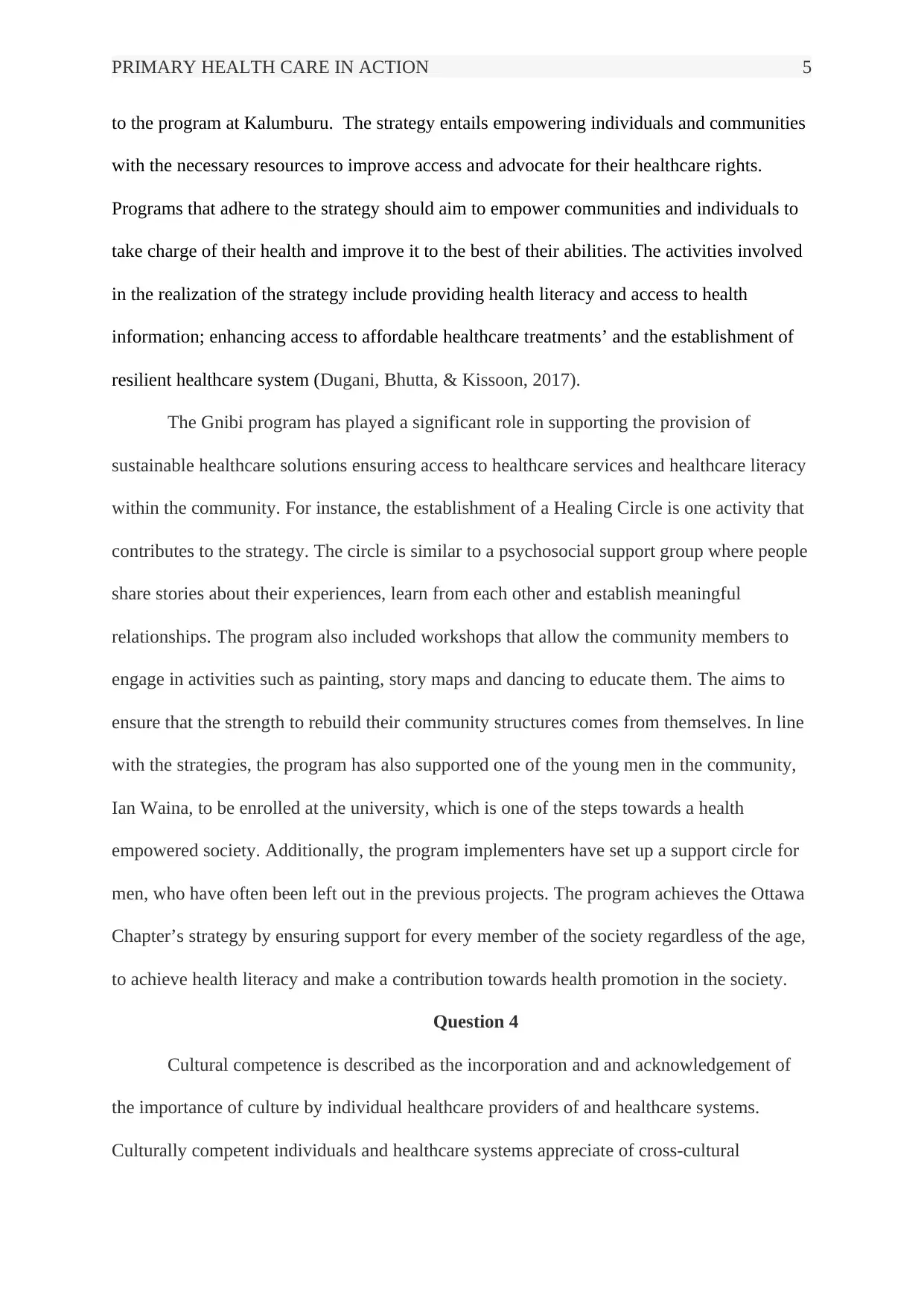
PRIMARY HEALTH CARE IN ACTION 5
to the program at Kalumburu. The strategy entails empowering individuals and communities
with the necessary resources to improve access and advocate for their healthcare rights.
Programs that adhere to the strategy should aim to empower communities and individuals to
take charge of their health and improve it to the best of their abilities. The activities involved
in the realization of the strategy include providing health literacy and access to health
information; enhancing access to affordable healthcare treatments’ and the establishment of
resilient healthcare system (Dugani, Bhutta, & Kissoon, 2017).
The Gnibi program has played a significant role in supporting the provision of
sustainable healthcare solutions ensuring access to healthcare services and healthcare literacy
within the community. For instance, the establishment of a Healing Circle is one activity that
contributes to the strategy. The circle is similar to a psychosocial support group where people
share stories about their experiences, learn from each other and establish meaningful
relationships. The program also included workshops that allow the community members to
engage in activities such as painting, story maps and dancing to educate them. The aims to
ensure that the strength to rebuild their community structures comes from themselves. In line
with the strategies, the program has also supported one of the young men in the community,
Ian Waina, to be enrolled at the university, which is one of the steps towards a health
empowered society. Additionally, the program implementers have set up a support circle for
men, who have often been left out in the previous projects. The program achieves the Ottawa
Chapter’s strategy by ensuring support for every member of the society regardless of the age,
to achieve health literacy and make a contribution towards health promotion in the society.
Question 4
Cultural competence is described as the incorporation and and acknowledgement of
the importance of culture by individual healthcare providers of and healthcare systems.
Culturally competent individuals and healthcare systems appreciate of cross-cultural
to the program at Kalumburu. The strategy entails empowering individuals and communities
with the necessary resources to improve access and advocate for their healthcare rights.
Programs that adhere to the strategy should aim to empower communities and individuals to
take charge of their health and improve it to the best of their abilities. The activities involved
in the realization of the strategy include providing health literacy and access to health
information; enhancing access to affordable healthcare treatments’ and the establishment of
resilient healthcare system (Dugani, Bhutta, & Kissoon, 2017).
The Gnibi program has played a significant role in supporting the provision of
sustainable healthcare solutions ensuring access to healthcare services and healthcare literacy
within the community. For instance, the establishment of a Healing Circle is one activity that
contributes to the strategy. The circle is similar to a psychosocial support group where people
share stories about their experiences, learn from each other and establish meaningful
relationships. The program also included workshops that allow the community members to
engage in activities such as painting, story maps and dancing to educate them. The aims to
ensure that the strength to rebuild their community structures comes from themselves. In line
with the strategies, the program has also supported one of the young men in the community,
Ian Waina, to be enrolled at the university, which is one of the steps towards a health
empowered society. Additionally, the program implementers have set up a support circle for
men, who have often been left out in the previous projects. The program achieves the Ottawa
Chapter’s strategy by ensuring support for every member of the society regardless of the age,
to achieve health literacy and make a contribution towards health promotion in the society.
Question 4
Cultural competence is described as the incorporation and and acknowledgement of
the importance of culture by individual healthcare providers of and healthcare systems.
Culturally competent individuals and healthcare systems appreciate of cross-cultural
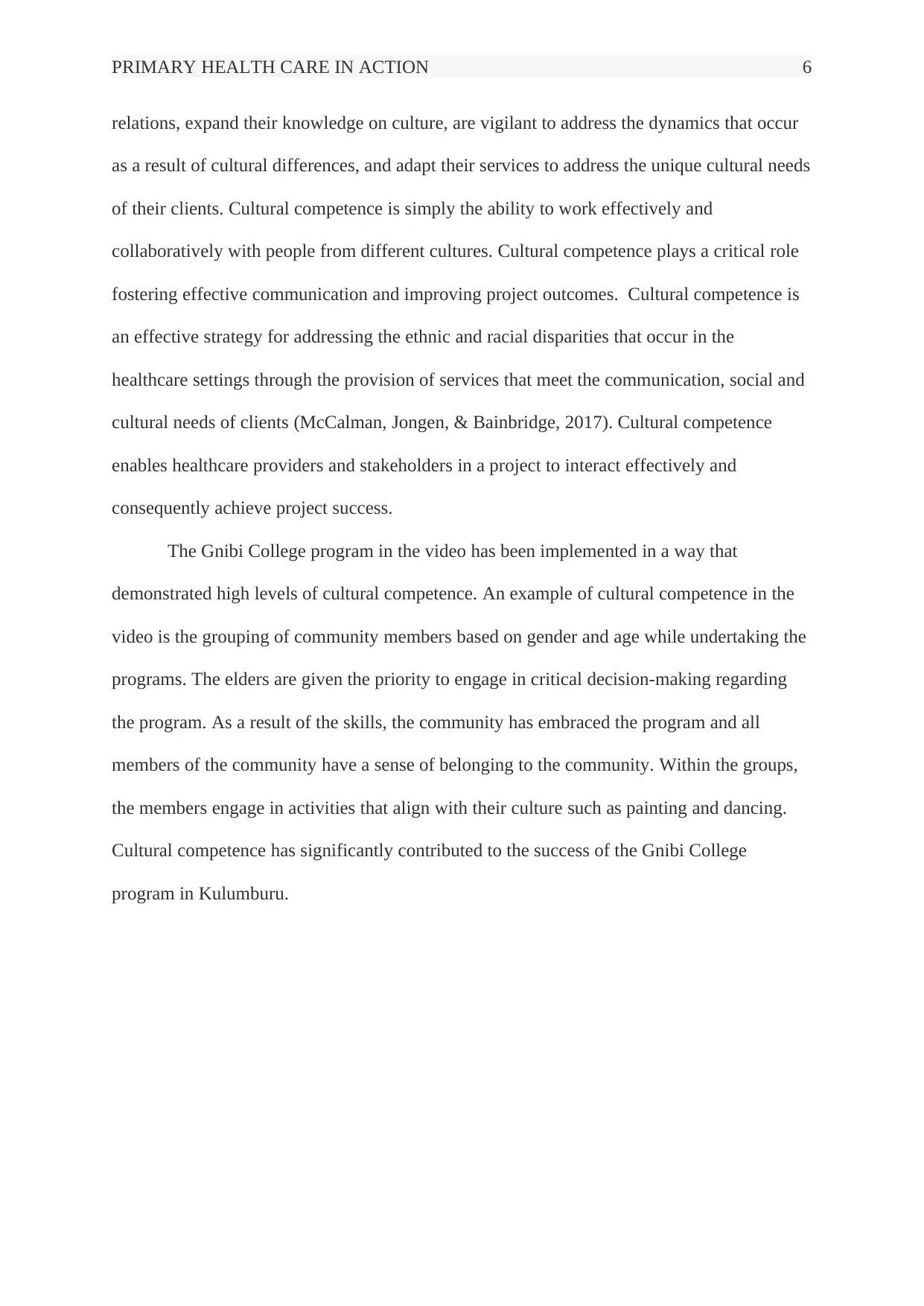
PRIMARY HEALTH CARE IN ACTION 6
relations, expand their knowledge on culture, are vigilant to address the dynamics that occur
as a result of cultural differences, and adapt their services to address the unique cultural needs
of their clients. Cultural competence is simply the ability to work effectively and
collaboratively with people from different cultures. Cultural competence plays a critical role
fostering effective communication and improving project outcomes. Cultural competence is
an effective strategy for addressing the ethnic and racial disparities that occur in the
healthcare settings through the provision of services that meet the communication, social and
cultural needs of clients (McCalman, Jongen, & Bainbridge, 2017). Cultural competence
enables healthcare providers and stakeholders in a project to interact effectively and
consequently achieve project success.
The Gnibi College program in the video has been implemented in a way that
demonstrated high levels of cultural competence. An example of cultural competence in the
video is the grouping of community members based on gender and age while undertaking the
programs. The elders are given the priority to engage in critical decision-making regarding
the program. As a result of the skills, the community has embraced the program and all
members of the community have a sense of belonging to the community. Within the groups,
the members engage in activities that align with their culture such as painting and dancing.
Cultural competence has significantly contributed to the success of the Gnibi College
program in Kulumburu.
relations, expand their knowledge on culture, are vigilant to address the dynamics that occur
as a result of cultural differences, and adapt their services to address the unique cultural needs
of their clients. Cultural competence is simply the ability to work effectively and
collaboratively with people from different cultures. Cultural competence plays a critical role
fostering effective communication and improving project outcomes. Cultural competence is
an effective strategy for addressing the ethnic and racial disparities that occur in the
healthcare settings through the provision of services that meet the communication, social and
cultural needs of clients (McCalman, Jongen, & Bainbridge, 2017). Cultural competence
enables healthcare providers and stakeholders in a project to interact effectively and
consequently achieve project success.
The Gnibi College program in the video has been implemented in a way that
demonstrated high levels of cultural competence. An example of cultural competence in the
video is the grouping of community members based on gender and age while undertaking the
programs. The elders are given the priority to engage in critical decision-making regarding
the program. As a result of the skills, the community has embraced the program and all
members of the community have a sense of belonging to the community. Within the groups,
the members engage in activities that align with their culture such as painting and dancing.
Cultural competence has significantly contributed to the success of the Gnibi College
program in Kulumburu.
⊘ This is a preview!⊘
Do you want full access?
Subscribe today to unlock all pages.

Trusted by 1+ million students worldwide
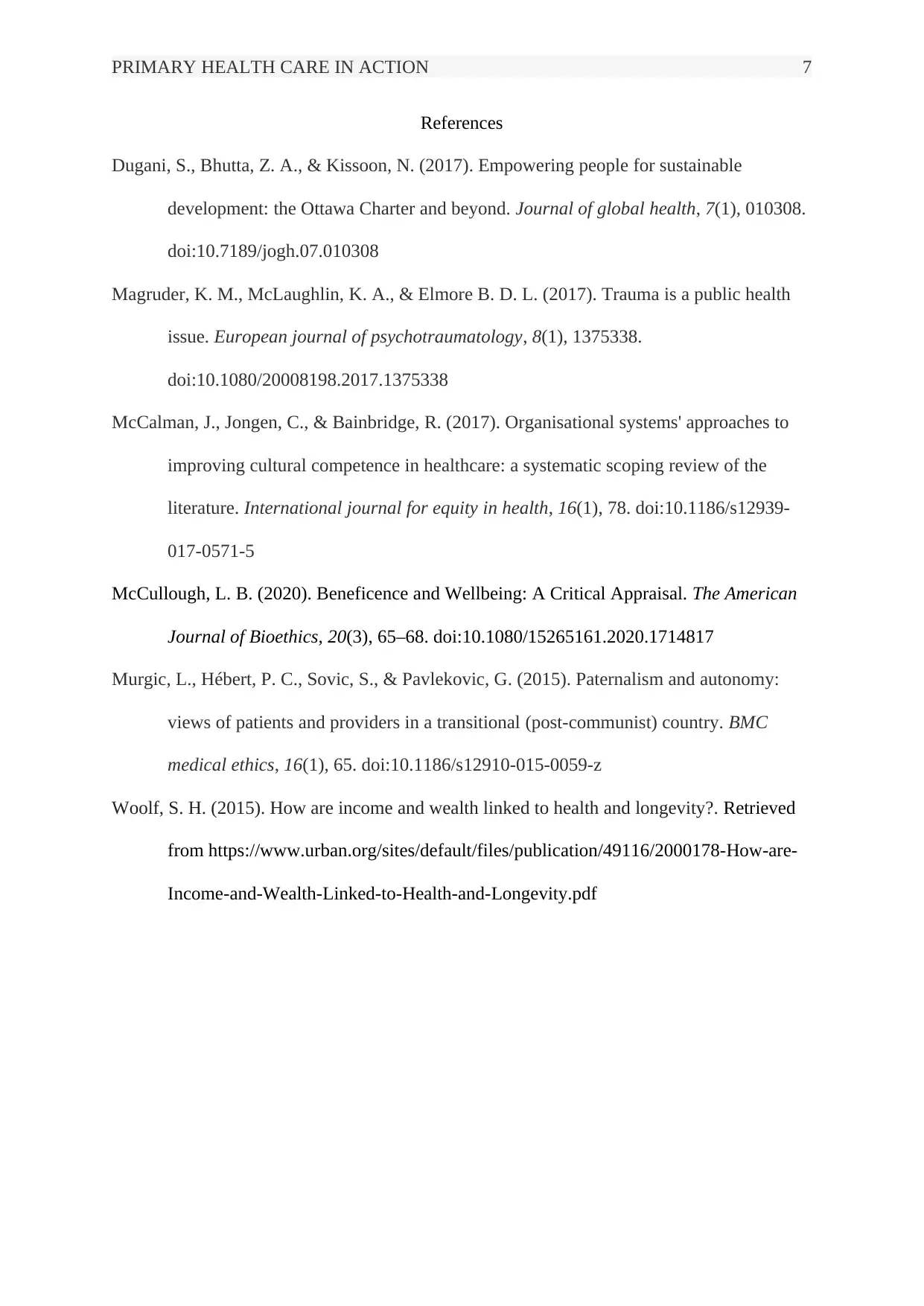
PRIMARY HEALTH CARE IN ACTION 7
References
Dugani, S., Bhutta, Z. A., & Kissoon, N. (2017). Empowering people for sustainable
development: the Ottawa Charter and beyond. Journal of global health, 7(1), 010308.
doi:10.7189/jogh.07.010308
Magruder, K. M., McLaughlin, K. A., & Elmore B. D. L. (2017). Trauma is a public health
issue. European journal of psychotraumatology, 8(1), 1375338.
doi:10.1080/20008198.2017.1375338
McCalman, J., Jongen, C., & Bainbridge, R. (2017). Organisational systems' approaches to
improving cultural competence in healthcare: a systematic scoping review of the
literature. International journal for equity in health, 16(1), 78. doi:10.1186/s12939-
017-0571-5
McCullough, L. B. (2020). Beneficence and Wellbeing: A Critical Appraisal. The American
Journal of Bioethics, 20(3), 65–68. doi:10.1080/15265161.2020.1714817
Murgic, L., Hébert, P. C., Sovic, S., & Pavlekovic, G. (2015). Paternalism and autonomy:
views of patients and providers in a transitional (post-communist) country. BMC
medical ethics, 16(1), 65. doi:10.1186/s12910-015-0059-z
Woolf, S. H. (2015). How are income and wealth linked to health and longevity?. Retrieved
from https://www.urban.org/sites/default/files/publication/49116/2000178-How-are-
Income-and-Wealth-Linked-to-Health-and-Longevity.pdf
References
Dugani, S., Bhutta, Z. A., & Kissoon, N. (2017). Empowering people for sustainable
development: the Ottawa Charter and beyond. Journal of global health, 7(1), 010308.
doi:10.7189/jogh.07.010308
Magruder, K. M., McLaughlin, K. A., & Elmore B. D. L. (2017). Trauma is a public health
issue. European journal of psychotraumatology, 8(1), 1375338.
doi:10.1080/20008198.2017.1375338
McCalman, J., Jongen, C., & Bainbridge, R. (2017). Organisational systems' approaches to
improving cultural competence in healthcare: a systematic scoping review of the
literature. International journal for equity in health, 16(1), 78. doi:10.1186/s12939-
017-0571-5
McCullough, L. B. (2020). Beneficence and Wellbeing: A Critical Appraisal. The American
Journal of Bioethics, 20(3), 65–68. doi:10.1080/15265161.2020.1714817
Murgic, L., Hébert, P. C., Sovic, S., & Pavlekovic, G. (2015). Paternalism and autonomy:
views of patients and providers in a transitional (post-communist) country. BMC
medical ethics, 16(1), 65. doi:10.1186/s12910-015-0059-z
Woolf, S. H. (2015). How are income and wealth linked to health and longevity?. Retrieved
from https://www.urban.org/sites/default/files/publication/49116/2000178-How-are-
Income-and-Wealth-Linked-to-Health-and-Longevity.pdf
1 out of 7
Related Documents
Your All-in-One AI-Powered Toolkit for Academic Success.
+13062052269
info@desklib.com
Available 24*7 on WhatsApp / Email
![[object Object]](/_next/static/media/star-bottom.7253800d.svg)
Unlock your academic potential
Copyright © 2020–2025 A2Z Services. All Rights Reserved. Developed and managed by ZUCOL.




